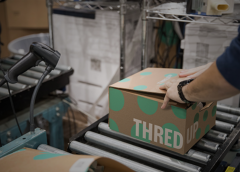
ThredUp Layoffs Hit 15% of Fashion Resale Giant’s Corporate Staff – Sourcing Journal
[ad_1]
ThredUp is laying off approximately 15 percent of its corporate workforce and closing one of its processing centers in Lebanon, Tenn. as the resale marketplace cuts costs across headcount, R&D and capital expenditures.
The company generated revenue of $76.4 million, an increase of 27.5 percent year-over-year, on a net loss of $28.4 million.
In a Nutshell: Like top resale competitor Poshmark, ThredUp is struggling to turn a profit, and economic uncertainties are only making matters worse. Co-founding CEO James Reinhart, speaking to Wall Street analysts Monday, said the consumer environment is “much different than it was just two months ago.”
“All the data that we’re seeing indicates that consumer health is deteriorating, especially among the budget consumer that makes up a meaningful portion of our customer base,” Reinhart said. “As such, we saw our business slow in the final weeks of Q2 a trend that has continued into Q3.”
Consumers are more sharply dividing along economic lines, with average order values (AOVs) from the company’s “deep discount” shoppers declining 7 percent from last year, according to Reinhart. Meanwhile, upscale shoppers’ AOV increased 15 percent.
The bifurcation is even more pronounced when accounting for the type of products consumers are shopping for, he said. The deep discount shoppers are now buying goods that are 24 percent less expensive, while typical budget shoppers are trading down to items that are 8 percent cheaper. Meanwhile, the upscale shopper is doing the opposite—purchasing items that are 8 percent more expensive.
“Although we’ve only seen a slight dip in the number of upscale shoppers buying with us, we’ve seen a 23 percent decline across discount and budget shoppers in July compared to the same period in May,” Reinhart said. “Discount and budget shoppers make up about one-third of our customer base. So essentially nearly one in four of them are sidelining themselves from apparel purchases right now.”
Going ahead, ThredUp is focused on its new goal to break even on an adjusted EBITDA level by the back half of 2023, with the job cuts and processing center closure being the first steps in that direction. ThredUp did not specify how many employees were impacted by the layoffs. The company started the year with 398 employees outside of its distribution centers, which employed an additional 2,496 workers.
ThredUp also is tapping the brakes on its in-development Dallas fulfillment center, which was initially expected to accommodate as many as 10 million items.
“We’ll build out Phase 1 at first which will hold about five million items,” chief financial officer Sean Sobers said “And then we’ll build out the second half as needed as we go through it.”
The company is also pulling back on spend in areas such as marketing and inbound processing in response to slowing demand. In the third and fourth quarters, ThredUp expects these actions to save about $12 million to $18 million.
But despite the cost reductions, the resale company slashed its full-year guidance for the second time, signaling choppy waters ahead. For the full year of 2022, ThredUp now expects revenue in the range of $283 million to $287 million—up 12.4 percent to 14 percent—down from the previous $315 million to $325 million range, which would have represented 25.1 percent to 29.1 percent growth.
Third-quarter guidance projects revenue in the range of $64 million to $66 million—amounting to 1.1 percent to 4.2 percent growth. Gross margin is projected in the range of 65 percent to 67 percent.
For now, the marketplace is still attracting new consumers. Total quarterly active buyers jumped 28.6 percent to 1.72 million, up from 1.34 million in the 2021 second quarter. Total orders soared 39.9 percent in the period to 1.70 million from 1.22 million in the year-ago quarter.
The “resale-as-a-service” (RaaS) company recently launched Resale 360 for Tommy Hilfiger, as well as a resale platform for sustainable fashion brand Oak + Fort. The company remains on track to have more than 40 brands on its RaaS platform by year end.
Inventory shot up 219.6 percent to $13.9 million from $4.4 million last year.
Second-quarter gross margin of 68.9 percent, down 4.7 percentage points from the 73.6 percent margin rate in the 2021 second quarter. Gross margins in the U.S. business reached a record 74.2 percent.
The lower gross margin was largely due to consolidation of the European resale business, Remix, it acquired last year.
“Over the next few years, we plan to migrate the European business towards higher margin consignment,” Sobers said. “In the near term, Europe’s product revenue margins are materially lower than ThredUp U.S.’s product margin and we see ample opportunities to improve its product revenue margins through investments in automation and data science in order to be closer to the 50 percent range that the U.S. product margins command.”
Cash, cash equivalents, restricted cash and short-term marketable securities were $155.7 million at the quarter end.
Net Revenue: ThredUp’s second-quarter revenue came in at $76.4 million, an increase of 27.5 percent year-over-year from the $60 million in the prior-year quarter.
Consignment revenue was flat, coming in at $48.5 million compared to $48.6 million in the year-ago period.
Product revenue contributed to most of the revenue increase, skyrocketing 145.4 percent to $27.9 million from $11.4 million. According to Sobers, much of the product revenues growth is due to the Remix acquisition and growth of the RaaS channel.
Net Earnings: Net loss was $28.4 million for the second quarter 2022, doubling the $14.4 million net loss in the year-ago period. In line with the losses, ThredUp saw net losses per share of 29 cents, also nearly doubling the 15 cents per share lost in the 2021 period.
Adjusted EBITDA loss was $13.5 million for the quarter, widening from the adjusted EBITDA loss of $9 million for the 2021 quarter.
CEO’s Take: Reinhart believes the economic environment is stabilizing, which should help ThredUp reach its $80 million to $85 million revenue run rate goal next year.
“I think our posture running the business is to be flexible. We sort of built that into our assumptions that it’s going to be more competitive. And so, we’re going to have to flex price, promotion, discounts and payouts to our sellers,” Reinhart said. “So we’re willing to flex all of those things to be competitive in the environment. But our guidance reflects what we expect to be a competitive environment in the back half of the year and into 2023.”
[ad_2]
Source link


